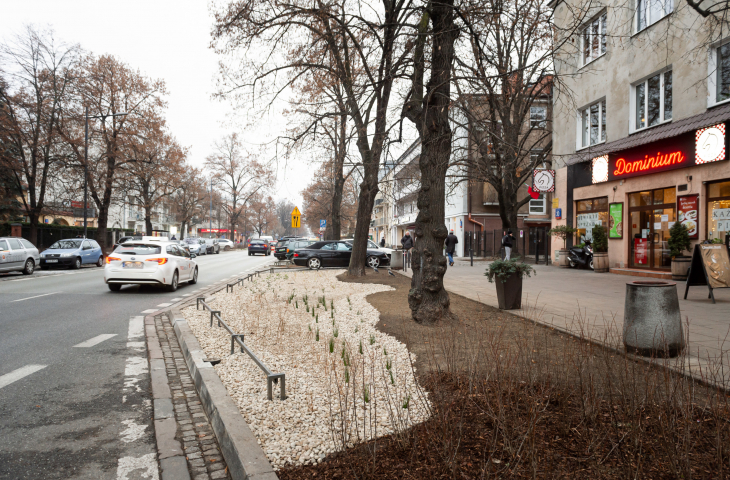Warsaw's Francuska Street in Saska Kępa is changing its face with small-scale interventions. Rain gardens are replacing unnecessary paved spaces, giving space to greenery and reducing the effects of heavy rainfall. This is one of several places where the City Roads Administration is carrying out this type of activity, which is mainly about correcting its own mistakes (and those of the designers) from a few(teen) years ago.
Rain garden on Francuska Street in Warsaw
Photo: ZDM
Small facelift, big changes
The changes being made to the space of Warsaw's streets consist of small corrections in their course, changing curves, or removing unnecessary paving slabs from places not used by pedestrians. In this way, additional space is obtained for greenery, which significantly improves the aesthetics of street space. These changes are also the aftermath of the enactment of Warsaw's "Climate Change Adaptation Strategy." The document prepared by the capital's City Hall introduces a recommendation to increase biologically active space on streets. This applies to both designed and existing roads. On French Street, ZDM has planted a total of almost nine thousand different species of shrubs. It has also removed more than a thousand square meters of unnecessary concrete pavement.
Comparison of past and present state
photo: ZDM
Not only aesthetics
With the change in the use of street spaces, not only its appearance is changing. Wild parking is cleaned up, streets become more pleasant to be in their space, but most importantly, the city gains additional scattered areas of greenery. Local flooding and waterlogging are a significant affliction for residents of many Polish cities, which they have to contend with during violent storms and downpours. They are often the aftermath of poorly designed streets, whose space subordinated to the convenience of car drivers has left no room for green areas. With the removal of unnecessary concrete spaces, Warsaw is gaining areas capable ofabsorbing excess water. In particular, these are specially designed rain gardens. These gardens will provide roadway drainage and rainwater retention. They consist of several layers of gravel and sand, allowing water to soak into the ground - the excess water, once the garden fills, will be discharged into the sewer system. Their smooth functioning is also made possible by specially selected greenery - marsh pansy, water mint, irises, yarrow, marsh pentice, yellow scythe and scattered rush.
Comparison of past and present state
photo ZDM
Climate change adaptation strategy
The changes being implemented concern a street that underwent its last major renovation in 2010. In 2020, however, more such work was done, including on Ludna and Gorczewska streets. The corners of intersections at several points in the city have gained greenery, including on the John Paul II Avenue, which is being rebuilt. These and other changes being implemented in the city are intended to implement the goals of the adopted strategy until 2030.
We see what is happening in Poland and Europe. We have weather anomalies: incredible heat, floods, windstorms, there is even a threat to the supply of electricity to major cities. This has to be countered. Warsaw is getting into the fight against climate change. The first step is the Warsaw Plan for Climate.
Rafał Trzaskowski
The city's actions are to be based on four pillars. To mitigate climate change, investments will be needed in greenery and water storage reservoirs, renewable energy sources, green public transportation and reduction of carbon emissions. City buildings are to be equipped with photovoltaic panels and green roofs, rich in shrubs and climbers.








































